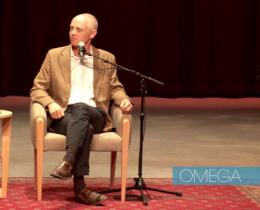1. Be Present While on Retreat
One way to prepare for what comes after a retreat is to sink in and experience the retreat itself. It can be tempting to think ahead, to imagine the conversations you'll have or the coffee you'll drink after you've survived the ordeal. But if you've put yourself in the fire of practice in the hopes of experiencing transformation, you'll need to actually sit in the fire.
Being present to the learning and transformation that can happen on a retreat will set you up for more success post-retreat. Spiritual teacher Tosha Silver says, "I often tell people to plant the seed for their life after retreat while they're in the retreat. Let the tools and the prayers get planted in you so the divine can take over whether you're in a silent retreat or standing in line at the pharmacy. Once you have the means to be guided from the inside out, you can have presence and quiet anywhere."
2. Don’t Come Back
You are not the same as you were at the beginning of the retreat, so don’t try to be. Spiritual teacher and silent retreat leader Adyashanti says, “I like to tell people, 'When you go on retreat, don’t ever come back!' I don’t mean don’t physically come back from the retreat. You physically come back, of course, but never let go of whatever it was that you oriented toward during retreat. Whether it was truth, peace, freedom, love—if you maintain the same orientation in your everyday life, and keep it in the forefront of your consciousness, it will transform you completely.”
3. Get Grounded
Judson Brewer, director of research at the Center for Mindfulness, says, “The reintegration process can be challenging and somewhat discombobulating. I try to make sure people are grounded in their senses before they drive off so they don’t become dangerous on the road.”
When you walk out of the meditation hall for the last time, pace yourself. Stop and look at the sky, smell the air, or touch a tree as you walk by. Take your time getting to your car or the bus or subway and enjoy the walk.
4. Pay Attention!
When you shift out of retreat and back into your life, you will likely default back into some habits and patterns that weren’t relevant during retreat (like sleeping with your phone or binge watching). “Life on retreat is very simple, for the most part. So I understand after retreat, when life gets complicated, it’s easier to fall back into conditioned patterns, but this is another opportunity to be awake and mindful,” explains Adyashanti.
When you see places in your life where you may previously have been on autopilot, it’s a chance to bring the same compassion to yourself in these moments that you brought to yourself while on retreat. In this way you can use your transition home to learn more about your patterns, bring kindness and compassion to yourself, and possibly make changes in areas of your life you'd like to change.
5. Build in a Buffer
While this isn’t always possible, it’s ideal if you can give yourself some time to slowly re-integrate by building in time at home before you return to work. “The world can seem very loud and fast after retreat. There are so many stimuli now, and the rapid pace of life can make you feel like you need to get onboarded really quickly,” says Brewer. “The first three days can be disorienting. If you have to go to work, try to minimize the number of meetings. If you can, avoid scheduling social activities for a week or so.”
6. Consider Your Family
If you’re returning to a partner, kids, pets, and a generally busy household, take special care. You may not feel like talking, or you may be so relieved to be able to talk that you talk nonstop. Your family will have their own reaction to your transition home. It can help to talk with your family a little about how to navigate your return before you leave for retreat, but it will help even more to be in the present with whatever arises when you all reunite.
Also remember that others have been keeping things going while you were gone. Brewer notes, “When your spouse asks you, 'How was it?,' they’re probably looking for a thank you for holding down the fort as opposed to a description of how great it was to not have to cook, clean, or watch the kids.”
7. Plug Back In Mindfully
One of the greatest benefits of going on retreat is the opportunity for a digital detox. This can also be one of the trickiest areas of life to transition back into. Insight Meditation teacher Tara Brach explains, "I like to frame what we're up against with this quote from American statistician Edward Tufte, 'Only two industries refer to their customers as 'users': computer design and drug dealing.' Whether we like it or not, the digital world is a part of our life now, and we can either let it cut us off from presence and true intimacy or we can use it as part of our practice."
In addition to seeing if it's possible to have a gradual re-entry into the digital world by not jumping in all at once, she suggests that before you leave retreat you set an intention for how you want to relate to your digital life. Ask yourself, do I want to limit unnecessary activity to certain times of the day or certain lengths of time? Do I want to avoid email until after I meditate in the morning?
Brach adds, "Once you're home and back online, watch what happens when you come up for air after emailing or being on social media and be aware of how it affects your quality of presence, clarity, and openheartedness. Honest reflection can help you live a more purposeful digital life, one that helps to weave presence through the whole of your life."



